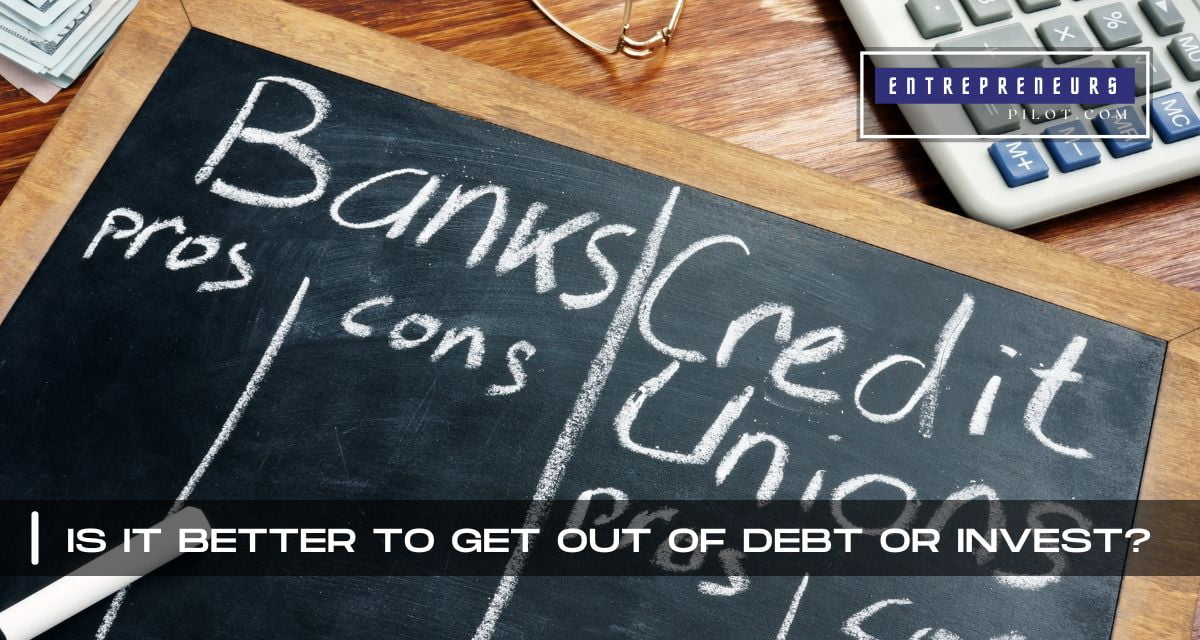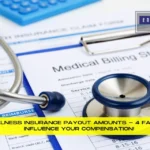Is It Better To Get Out Of Debt Or Invest? Deciding between paying off debt or investing can feel like standing at a financial crossroads, unsure which path will lead to a prosperous future. Trust me, you’re not alone in wrestling with this dilemma. So, is it smarter to channel your funds into investments, hoping for a generous return, or to diligently clear that looming debt, bit by bit? The answer, frustrating as it might sound, isn’t one-size-fits-all, and it may even be a mix of both strategies.
Table of Contents
First, let’s chat about debt. Carrying a mountain of debt isn’t just financially draining; it’s emotionally exhausting too. Every dollar you use to pay interest is a dollar that’s not growing your wealth. High-interest debts like credit cards can be particularly toxic. When you’re paying a 20% interest rate, wiping that out is essentially like earning a 20% return risk-free. That’s an opportunity too good to pass up.
But hey, let’s not discount the magic of investing. If you’re young and the interest rates on your debt are low, the long-term benefits of investing can be compelling. Think compound interest, the snowball effect where your earnings generate even more earnings. Over time, this can be a massive financial boon. And if your employer is matching your 401(k) contributions, then by all means, you’re leaving free money on the table if you don’t invest.
Balancing the two approaches may be your golden ticket. Prioritize high-interest debts, but don’t ignore long-term investment opportunities. And if you’re just not sure what to prioritize, consider speaking to a financial advisor. They can provide a tailored plan that aligns with your financial goals and risk tolerance.
In essence, both paying off debt and investing have their merits, and the ‘better’ choice really comes down to your personal circumstances—your existing debt, risk appetite, and financial aspirations. So take a deep breath, evaluate your options, and remember: the best decision is an informed one.
- For Expert Financial Insights And Guidance, You Can Visit Our Sister Site – ArabsGeek.com Now!
- Curiosity Piqued? Dive Into the Most Captivating Financial Content by Visiting Our Homepage!
- Unlock Exclusive Business Opportunities! 🚀 Connect with Us Now at our Email: [email protected]!
What Are The 4 Different Types Of Debt
Making wise financial decisions requires a thorough understanding of the debt environment, and guess what? Not all debt is the same. There are four main categories of debt, each with their own regulations, rates, and effects on your financial situation. To help you better manage your funds, let’s break them down.
01. Secured Debt: This type of debt requires collateral, which gives you some stake in the outcome. Consider a home mortgage or a car loan. The lender has the right to take the collateral as payment if you don’t make the agreed-upon payments. The bright side? The interest rates for secured debt are often cheaper because the lender has a safety net in place.
02. Unsecured Debt: This category frequently includes credit cards, personal loans, and student loans. These loans are riskier for lenders because there is no collateral supporting them. How does that affect you? My friend, higher interest rates. If you’re not careful, it’s simple to fall into a debt spiral in this area, especially with all the tempting credit card offers.
03. Revolving debt: This kind is flexible, allowing you to borrow, pay it back, and then borrow more money up to a set amount. The archetypal example of revolving debt is credit cards. Although it is convenient, there is always the possibility of succumbing to the urge to overspend.
04. Installment Debt: This type of debt follows a clear course. You take out a substantial sum of credit up front, then you repay it with regular payments over a predetermined time period. This is frequently how personal loans, vehicle loans, and mortgages operate. Although having predictable debt can be comfortable, your credit score can still suffer if you miss a payment.
In conclusion, how you manage your debt can be greatly affected by your understanding of the type of debt you’re dealing with. Knowing the specifics of different debt kinds will help you plan efficiently, whether you want to invest or concentrate on paying off debt. And keep in mind that you may always call for expert guidance if you’re unsure.
What Types Of Debt Can Be Consolidated
Debt consolidation can be a life-saver when you’re juggling multiple debts with varying interest rates and payment schedules. But hold on a second, not all debts are eligible for this financial Houdini act. Let’s dig into the types of debt that can often be bundled together for easier management and potentially lower interest rates.
- Credit Card Debt: This is the most common candidate for consolidation, and for good reason. Credit cards usually come with high-interest rates, making them a perfect fit for consolidation strategies that aim to reduce your overall interest burden.
- Unsecured personal loans: Whether you took out a personal loan for medical expenses, home improvement, or some other reason, these can usually be consolidated. Just make sure to compare the interest rates and terms to ensure you’re really getting a better deal.
- Medical Bills: If you’ve been hit with a flood of medical bills, consolidating them into a single loan with a lower interest rate can make the debt more manageable. However, some medical facilities offer interest-free payment plans, so weigh your options carefully.
- Student Loans: Both federal and private student loans can be consolidated, although the processes differ. Federal student loan consolidation is done through the federal government and results in a weighted average of the interest rates of the loans being consolidated. Private student loans can be consolidated through refinancing with a private lender, which could lead to a lower interest rate if you have good credit.
- Retail Store Cards: These cards often lure you in with initial discounts but usually have sky-high interest rates after the introductory period. Consolidating these debts can save you a significant amount in interest.
- Payday Loans: While these high-interest, short-term loans can technically be consolidated, proceed with caution. Many financial advisors recommend avoiding payday loans altogether, if possible, due to their exorbitant interest rates and fees.
- Auto Loans: These can sometimes be consolidated, but it’s less common. Because auto loans are secured with the vehicle as collateral, consolidating them often means converting secured debt into unsecured debt, which could result in a higher interest rate.
So there you have it—the types of debt that are generally eligible for consolidation. But a word to the wise: Before diving into debt consolidation, make sure you thoroughly understand the terms and potential fees involved. It might be a good idea to consult a financial advisor to make sure you’re making a move that truly benefits your financial well-being.
What Types Of Debt Does Bankruptcy Eliminate
The world of bankruptcy is difficult, perplexing, and emotionally draining, much like navigating a maze while wearing blinders. But let’s lift the veil on this frequently misunderstood procedure. While some debts may be erased via bankruptcy, it’s not a universal “reset button.” Here’s a closer look at the different types of debt—those that may usually be discharged through bankruptcy, and those that will cling to you like glue.
Debts That Can Be Wiped Out:
01. Debt from credit cards: This debt is typically unsecured, and both Chapter 7 and Chapter 13 bankruptcy can discharge it. Put an end to those bothersome balances.
02. Medical expenses: Are your medical expenses overwhelming you? These can typically be discharged in bankruptcy because they are unsecured debts.
03. Personal loans: Personal loans can typically be discharged through bankruptcy as long as they are unsecured (involve no collateral).
04. Utility Bills: Late fees for services like electricity and water are frequently waived. However, keep in mind that service providers may suspend your access if you don’t make payments, even while your case is in bankruptcy.
05. Rent arrears: If you owe rent, bankruptcy can eliminate the debt, but you should exercise caution because it won’t prevent eviction if your landlord is already evicting you.
06. Civil judgments: Unless they are tied to fraud, these debts can frequently be forgiven if you have been sued and lost.
Debts That Stick Around:
01. Student Loans: These are among the debts that endure. These are quite difficult to get rid of unless you can demonstrate “undue hardship,” which is a difficult standard to meet.
02. Alimony and Child Support: the legal priority is the family. Even after filing for bankruptcy, you are still responsible for these bills.
03. Secured Loans: Mortgages and auto loans are examples of secured loans; this means that if you don’t make payments, you’ll lose the asset.
04. Tax Debts: While some earlier tax bills may be forgiven, the majority will remain on your record.
05. Fines and Penalties: Government-imposed fines and penalties, such as traffic citations, cannot be discharged.
06. Criminal Restitution: Filing for bankruptcy won’t erase any court-ordered payments for criminal restitution.
The complicated process of bankruptcy affects more than just your obligations; it may also have an influence on your credit rating, future loan eligibility, and even your emotional health. To properly understand the ramifications for your specific financial situation, it is imperative that you sit down with an experienced bankruptcy attorney if you are thinking about taking this huge step.
Debt Are Inherited
The notion of inheriting debt can be a haunting concern, especially when navigating the already complicated process of dealing with a loved one’s passing. However, let’s clear the air: In most cases, you won’t inherit debt in the way you might inherit a family heirloom or property. But, as with many things in life, there are nuances and exceptions to consider.
What Generally Happens:
When someone passes away, their debts become the responsibility of their estate, not their family or heirs. This means that before any assets can be distributed to loved ones, the debts must first be settled using the estate’s resources. Executors or administrators typically handle this by liquidating assets, if necessary, to cover outstanding liabilities. If the debts exceed the assets, the estate is deemed insolvent, and the remaining debts usually die with the individual.
Exceptions and Special Cases:
- Cosigned or Joint Accounts: If you cosigned a loan or hold a joint account with someone who has passed away, you’re likely responsible for those debts.
- Community Property States: If you live in a community property state, you may be liable for debts incurred by a spouse during the marriage, even if you didn’t cosign for them.
- Home and Auto Loans: While you won’t “inherit” the debt, if you inherit the property or car tied to a loan, you’ll need to keep making payments to avoid foreclosure or repossession.
- Medical Bills: Some states have filial responsibility laws that could make adult children responsible for their parents’ medical debts under specific circumstances.
- Credit Card Debt: You’re generally not responsible for someone else’s credit card debt unless you’re a joint account holder. But note that credit card companies may try to get family members to pay, often without disclosing that they’re not legally obligated to do so.
- Taxes: If you inherit property, you might not inherit the debt, but you could inherit a tax liability. Inherited IRAs, for example, come with tax implications.
While inheriting debt is generally rare, it’s always wise to consult a financial advisor or an attorney specializing in estate planning or probate law when navigating these tricky waters. That way, you can understand your legal rights and obligations, and hopefully, find some peace of mind during a challenging time.
What Are The Three Types Of Debt Restructuring
When you’re knee-deep in debt, it feels like you’re navigating a labyrinth with no clear way out. However, debt restructuring can serve as a reliable compass, guiding you toward financial stability. This strategy allows borrowers to renegotiate the terms of their existing debts, making them more manageable. But, as with most financial matters, it’s not a one-size-fits-all solution. There are mainly three types of debt restructuring to consider, each tailored for specific situations.
- Loan Modification: In this approach, you work directly with your lender to alter the terms of your loan. This could mean extending the repayment period, lowering the interest rate, or even reducing the principal amount. Loan modifications are common in the realm of mortgages but can also be applied to other types of loans. The goal is to make payments more affordable, so you don’t default and face the subsequent financial fallout.
- Debt Consolidation: This is the process of taking out a new loan to pay off multiple existing debts, ideally at a lower interest rate. Imagine gathering all your debts into a single basket—you still have to carry it, but it’s much easier to manage. Credit card balances, personal loans, and even some types of auto loans can often be consolidated. Just be cautious; while your monthly payment may decrease, extending the repayment term could result in more interest paid over time.
- Debt Settlement: This is the more aggressive form of restructuring, where you or a debt settlement company negotiate with your creditors to accept a reduced lump-sum payment. While this can significantly cut down your debt, it’s a double-edged sword. Your credit score will take a hit, and you could face tax implications on the forgiven amount. Plus, there’s no guarantee that creditors will agree to a settlement.
Choosing the right debt restructuring approach depends on various factors like the types of debts you have, your financial health, and your long-term goals. Debt restructuring can indeed offer a lifeline, but it’s essential to remember that the impact on your credit score and future borrowing capability varies with each method. As always, consulting with financial experts before making such a pivotal decision is strongly recommended. After all, when you’re seeking a way out of the financial maze, a reliable guide can make all the difference.
What Are The Different Types Of Debt Financing
Navigating the business landscape often requires some financial leverage, and debt financing is a go-to strategy for many companies aiming to fuel growth. Essentially, it’s the act of borrowing capital that you promise to pay back within an agreed timeframe and at a predetermined interest rate. Simple enough, right? But hold on—debt financing isn’t a one-size-fits-all solution. There are several types to consider, each tailored for specific business needs and situations.
- Term Loans: Think of this as the bread and butter of business loans. You borrow a lump sum of money and repay it over a specific term with interest. These are often best for long-term investments like equipment purchase or expanding operations. Term loans can be short-term (less than one year), medium-term (1-5 years), or long-term (more than 5 years).
- Lines of Credit: This offers more flexibility, functioning like a credit card for your business. You’re approved up to a specific limit and only pay interest on the amount you’ve used. This is particularly useful for meeting short-term working capital needs or handling unexpected expenses.
- Equipment Financing: If your business relies heavily on machinery, technology, or other types of equipment, this loan is designed specifically for these purchases. You borrow money to buy the equipment, which itself often serves as collateral for the loan.
- Invoice Financing: Cash flow issues? Invoice financing allows you to borrow against your outstanding invoices. You receive an upfront percentage of the invoice amount from the lender, providing your business with instant cash. Once your customer pays the invoice, you repay the lender, minus their fee.
- SBA Loans: Backed by the U.S. Small Business Administration, these loans offer favorable terms and are designed to support small businesses. However, the application process is often rigorous, and qualification criteria can be strict.
- Trade Credit: This is an arrangement with your suppliers to purchase goods or services on account, paying them at a later agreed-upon date. It’s a convenient form of short-term financing, but late payments can harm your business relationships and credit score.
- Mezzanine Financing: This hybrid form of financing combines elements of debt and equity. You’ll receive a loan, but if it’s not paid back in time, the lender may convert the owed amount into ownership or equity stake. This is more common in acquisitions or for fast-growing companies.
- Convertible Debt: Primarily used in venture financing, these are short-term loans that can be converted into equity at a future date, usually at more favorable terms for the lender.
- Vendor Financing: In this scenario, the vendor themselves extends credit to you, allowing you to pay for goods or services at a later date. It’s a useful strategy for businesses building long-term relationships with vendors.
Remember, each type of debt financing comes with its own set of terms, interest rates, and requirements. Understanding the nuances can help you choose the most appropriate one for your business needs.
What Is Considered Debt Free
The phrase “debt-free” can sound like a magical incantation, promising days without worry and a life free from debt. But what does being debt-free actually entail? Being debt-free essentially means that you have no outstanding debts to any people or organizations. Nevertheless, the definition can vary based on your viewpoint and financial objectives.
Absolute Debt Free Status: Absolute debt freedom is defined as having no debt at all, including any mortgage, auto loan, school loan, credit card bill, or other type of loan. You are completely debt-free and the owner of all your assets. It’s as unblemished as a financial slate can be.
Relative Debt Free Status: For some individuals, becoming “debt-free” may not entail completely getting rid of all debt. For instance, even though you still owe money on your mortgage, you may believe that you are debt-free since you have eliminated your high-interest bills, such as credit card and personal loans, which are referred to as “bad debts.
Exception for “Good debt”: Some financial experts distinguish between “good debt” and “bad debt.” Good debt is viewed as an investment that will eventually produce value or income, like a decent mortgage or college loans. This viewpoint allows for the possibility of having some long-term, low-interest debt yet still considering oneself debt-free.
Why Not Having Debt Is Important: Not only does being debt-free bring peace of mind, but it also creates new financial opportunities. You have the freedom to invest, save, and generally make decisions that are in line with your personal and financial goals when you don’t have to worry about making monthly debt payments. It offers a sense of safety and stability, which is frequently the cornerstone for achieving future financial success.
The Warnings: While being debt-free is a desirable aim, it’s important to balance it with other financial goals like investing, retirement planning, and amassing an emergency fund. Utilizing debt strategically might occasionally aid in achieving longer-term financial rewards. Being debt-free must therefore be approached as a component of a larger financial plan.
So, do you have no debt? Depending on how you define it, the answer could vary. Regardless of how you define it, living a debt-free life, or even just making progress in that direction, can provide a sense of satisfaction and financial security that’s difficult to match.
Should You Invest With Debt
Navigating the tightrope between debt and investment is a financial quandary that many of us face at some point. You’re torn between aggressively paying down debt and taking advantage of potentially lucrative investment opportunities. While there’s no one-size-fits-all answer, the decision often boils down to a few crucial variables like the type of debt you have, its interest rate, and your overall financial picture.
Consider the Interest Rates:
One of the most straightforward ways to approach this dilemma is by comparing interest rates. If the interest rate on your debt is higher than what you could realistically expect to earn from investments, it’s generally wiser to pay off the debt first. Why? Because the cost of carrying that debt will likely outweigh any gains you’d make through investing.
Understand the Nature of Your Debt:
Not all debt is created equal. High-interest debts like credit card balances are often considered “bad debt,” and it usually makes sense to pay these off before considering any form of investment. On the other hand, “good debts” like a mortgage or student loans often have lower interest rates and offer tax benefits. In such cases, investing while holding onto the debt might be more justifiable.
Risk Tolerance and Financial Stability:
Investing always comes with risks, and market volatility could undermine your returns. If you’re also carrying debt, your financial footing becomes even more precarious. Evaluate your own risk tolerance and financial stability. If you’re just barely making your debt payments, investing could be too risky a move.
Liquidity Concerns:
Paying down debt provides a guaranteed “return” in the form of money saved on interest, but it also ties up your funds. Investments, especially in more liquid assets like stocks or bonds, can be sold off quickly if you face a financial emergency. That’s an advantage to consider, especially if you don’t have a robust emergency fund in place.
Long-term Financial Goals:
Your decision should also align with your long-term financial objectives. If you’re young and retirement seems a lifetime away, taking some calculated risks in the investment market might be worthwhile even if you have some low-interest debt. Conversely, if you’re nearing retirement, the security of being debt-free might hold more appeal.
In A Nutshell:
In a nutshell, while it’s entirely possible to invest while having debt, the approach should be cautious and well-calibrated to your individual circumstances. A balanced strategy that includes both debt repayment and strategic investment often yields the best long-term results.











